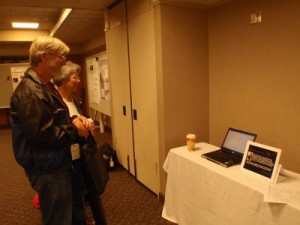
The animation, Antarctic Energies, screened at the GLOBEC conference on krill research. It was displayed during breaks on the large main screen, and continuously on a laptop as part of the Posters Presentation.
The interannual variation and abundance of Antarctic krill (Euphausia Superba) was the subject of the …presentation given by E. Murphy, …from the British Antarctic Survey. This presentation noted the possible influences of atmospheric processes (Antarctic Circumpolar Wave), winter habitat (sea ice extent), and ocean currents (Antarctic Circumpolar Current) in producing several interannual variations in Antarctic krill populations. Murphy showed results from long-term observations and numerical modeling studies which suggest that the current Antarctic krill biomass is reduced from what it was about fifty years ago. He highlighted the uncertainty in current climate model forecasts for the Southern Ocean, and discussed the range of potential impacts of climate change, including reducing the suitable habitat available to Antarctic krill and its predators, which could drastically alter the Antarctic food web.
Extract from Session 3: Antarctic Marine Ecosystems and Global Change, review by Eileen Hofman from Session Highlights of the Second GLOBEC Open Science Meeting June 2009
Antarctic Energies represents physical and biological forces that interact to shape Antarctica: diatoms, krill, sea butterfiles (pteropods), seals, humans, sea ice, bottom water circulation, the circumpolar current, ice melting, and sea levels rising. Circles and spirals, that trace gestures arising from human movement, have been animated to connect us with similar structures that exist in the Antarctic ecosystem. Circles and spirals are used as metaphors to evoke the reality of energy reciprocity that exists between us and our changing world. To draw from the hypothesis of marine scientist, Steve Nicol, it follows that just as our environment influences us; we influence our environment by the way that we behave.
Proposal
People who have not experienced Antarctica can connect to the insights of its research community through drawing, dance, and animation.
Problems
Antarctic is inaccessible for most people. It is difficult to describe the complex interaction of systems and energy flows that work together to shape its environment. It is difficult to describe the feeling of being in Antarctica.
Question
Can digital animation be used to combine human movement with hard scientific data and knowledge to connect people with Antarctica?
Context
The fields of this research include drawing, dance, animation, the polar arts, and physical and biological sciences.
Antarctica is an elemental space. It is often described as a void. Physical and biological systems can be more clearly observed in its uncluttered, pristine environment. A more elemental sense of one’s self can be experienced there. Scientists suggest that reciprocity exists between all living things and our environments, and call this the Gaia hypothesis. Evidence of reciprocity can be difficult to see in the scientific data collected from international research programs. Science is compartmentalized and is usually restricted to the scientific method to obtain a perspective of mechanisms working in the Antarctic ecosystem. Artists who have worked in Antarctica have evoked a sense of reciprocity between humans and our environments. Some have found compelling metaphors to connect their objective observations with their subjective responses to being there. Artists who combine their subjective responses with data produced by scientists empower or enhance new ways for people to identify with Antarctica. Although some artists represent aspects of Antarctica, few have used this approach to combine objective and subjective realities into a unifying perspective of energy interaction in the Antarctic ecosystem.
Methods
To develop and communicate with an Antarctic research community, and to display their scientific and poetic texts, a website with a blog was built (www.antarcticanimation.com). This site displays and documents animations that reflect their various insights. As can be seen in Antarctic Energies, these include insights into distinct key components of the Antarctic ecosystems and their physical and biological interactions. Contributors responded and advised on animations that were made using their data.
Face-to-face interviews were conducted with Antarctic researchers in Australia, New Zealand, Argentina and the United Kingdom. Correspondence with most of these people has continued throughout the project.
Methods of improvisation were used in drawing, dance, and digital animation. These methods were based on dance research by Joanna Exiner, who adapted the methods of pioneer movement analyst Rudolph Laban. This method describes human movement in terms of the body’s use of time, space, and energy. This elemental approach can describe a sense of being in Antarctica that is shared by some people. Workshops were conducted with several artists and dancers. Drawings and dances were made in response to imagining Antarctica, and to texts composed by Antarctic expeditioners. Animations were made to combine improvised drawings and gestures with scientific and poetic texts. Animations are displayed on the website and have been reviewed by contributing expeditioners, workshop participants, and the general public.
Key findings
Scientists easily recognise their knowledge and experience in digital animations that were made, sometimes feeling a strong sentimental connection with nature.
Circles and spirals that trace drawings and gestures arising from our human structure can reflect similar structures that exist in the Antarctic environment.
Scientific and artistic knowledge is usually freely shared amongst Arctic and Antarctic research communities.
People who have not experienced Antarctica can connect to the insights of its research community through drawing. dance, and animation.

